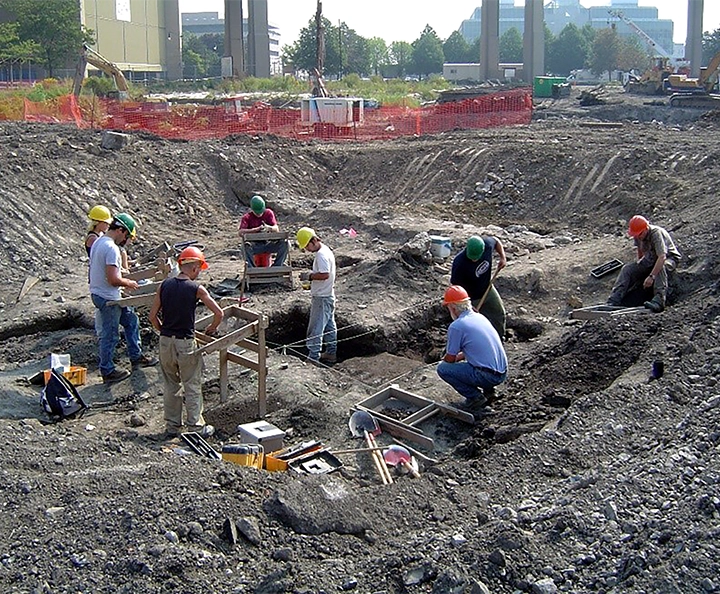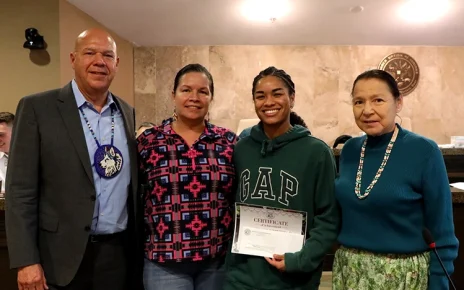April 7, 2025 | By Chronicle Heritage Buffalo Office
Chronicle Heritage’s Buffalo office delivered over 20,000 Native American artifacts, mostly tools and flakes, in 10 boxes to the Seneca Iroquois National Museum and Onöhsagwë:de’ Cultural Center. The delivery marked a return of artifacts to the descendants of Native Americans that created them long ago. In turn, the museum and cultural center honored Chronicle Heritage as a sponsor of its Ohi:yo’ Art Market.
The art market, which is being held May 3 from 10 a.m. – 5 p.m., is a celebration of Native American resiliency through art and culture. Native American artists from nations across the United States and Canada will participate in the art show competition and art market.
“We further welcome all visitors to experience the creativity and talent of today’s finest Native artists at the market,” the museum states on its website.
Multiple Discoveries Made at Canalside
The bulk of the collection given to the museum for curation was derived from a Panamerican Consultants (now Chronicle Heritage) project site on the Buffalo harbor called Canalside. Now a tourist destination, Panamerican conducted a cultural resources survey on the site in the early 2000s in advance of development. The site, owned by the Erie Canal Harbor Development Corporation, opened to the public in 2008.
The survey involved extensive excavation work by Panamerican, during which a number of discoveries were made.
“When we started working down there, the city didn’t know where the Erie Canal connected to the Buffalo River. In the process of finding the canal and excavating a lot of the foundations that were right next to the canal, we found a Native American site. We think it was from 4000 BC,” said Mark Steinback, Buffalo Office Principal at Chronicle Heritage.
According to the City of Buffalo, Canalside was a site of prehistoric occupation from 4000 BC to about AD 1500. The site has significance as an ancestral land of the Hodínöhšö:ni:h, also known as the Six Nations Iroquois Confederacy. Hodínöhšö:ni:h means “people of the longhouse,” referring to their dwellings.
The discovery of the artifacts wasn’t a surprise to Steinback given the location of the dig site, although the sheer volume of artifacts collected was.
“It was right there on the canal where Lake Erie connects to the Niagara River, so that is a major point for fishing and collecting maritime food sources. The locals probably fished there, and then in the process of waiting to collect the fish, they were sharpening tools, making things and killing time, just whittling points,” he said. “It makes sense because on the other side of the river is Canada, and there’s a major native site on that side of the river. It’s not unheard of that they would go back and forth. They could have lived on the other side and just came across to fish and make tools. Either way, it was a good fishing spot.”
“Still, to find that many artifacts there was quite surprising,” he added.
Panamerican collected, recorded and preserved the artifacts in boxes. Then, the boxes sat and essentially collected dust. In the meantime, Steinbeck reached out to the Erie Harbor Development Corporation, which owned the land and therefore owned the artifacts.
“In New York, if you’re the landowner, the artifacts belong to you because you own the land,” said Steinback. “First, we had to connect with the Erie Canal Harbor Development Corporation to get them to sign off. Since they owned the project, they owned the artifacts. They signed off, pushing control to us. And then we contacted the Seneca Iroquois National Museum.”
Returning Artifacts to Rightful Owners
When possible, Chronicle Heritage tries to provide artifacts collected on project sites to appropriate cultural heritage institutions and organizations. With this in mind, our Buffalo office reached out to the Seneca Iroquois National Museum to gauge its interest in the 10 boxes of artifacts.
“We were happy to accept them,” said Hayden Haynes, director of the museum and cultural center.
Haynes added that he came up with the idea to have Chronicle Heritage sponsor the art market.
“The museum charges an intake fee of a hundred dollars per box because of space limitations. We get a lot of artifacts, and, unfortunately, we have to turn a lot of things away,” said Haynes. “We were already looking for sponsors to help support the prize money for the art competition, so that’s when I decided that if Chronicle Heritage was going to give us a thousand dollars, they should sponsor the event.”
Erie Canal Bicentennial Connection
2025 also marks the 200th anniversary of the opening of the Erie Canal in Buffalo. As part of the bicentennial commemoration, “Waterway of Change: A Complex Legacy of the Erie Canal,” a new Erie Canal bicentennial visitor experience is set to open at Canalside in May 2025, according to a press release from Empire State Development, New York State’s chief economic development agency.
“With Waterway of Change, we aim to highlight the diverse perspectives that connect people to Buffalo’s waterfront history—from the Hodínöhšö:ni:h’s stewardship of this land to the innovations of the Canal era—encouraging visitors to see this history as a living force that continues to shape our region and its future,” Melissa Brown, Executive Director of The Buffalo History Museum, said in the release.
The new exhibit at the visitor’s center, located at the 1825 terminus of the Erie Canal, will trace Canalside’s history, beginning with its significance as the ancestral land of the Hodínöhšö:ni:h and acknowledging the impacts of their displacement, according to the release.
“As a result of what we’ve done, Canalside is now a historic district,” said Steinback.




